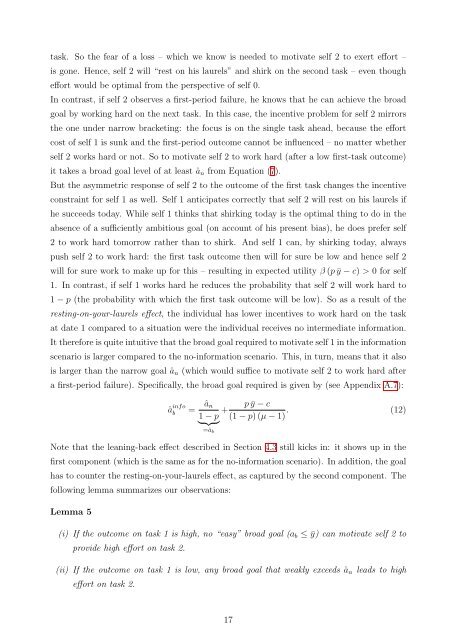Motivational Goal Bracketing - School of Economics and ...
Motivational Goal Bracketing - School of Economics and ...
Motivational Goal Bracketing - School of Economics and ...
Create successful ePaper yourself
Turn your PDF publications into a flip-book with our unique Google optimized e-Paper software.
task. So the fear <strong>of</strong> a loss – which we know is needed to motivate self 2 to exert effort –<br />
is gone. Hence, self 2 will “rest on his laurels” <strong>and</strong> shirk on the second task – even though<br />
effort would be optimal from the perspective <strong>of</strong> self 0.<br />
In contrast, if self 2 observes a first-period failure, he knows that he can achieve the broad<br />
goal by working hard on the next task. In this case, the incentive problem for self 2 mirrors<br />
the one under narrow bracketing: the focus is on the single task ahead, because the effort<br />
cost <strong>of</strong> self 1 is sunk <strong>and</strong> the first-period outcome cannot be influenced – no matter whether<br />
self 2 works hard or not. So to motivate self 2 to work hard (after a low first-task outcome)<br />
it takes a broad goal level <strong>of</strong> at least ân from Equation (7).<br />
But the asymmetric response <strong>of</strong> self 2 to the outcome <strong>of</strong> the first task changes the incentive<br />
constraint for self 1 as well. Self 1 anticipates correctly that self 2 will rest on his laurels if<br />
he succeeds today. While self 1 thinks that shirking today is the optimal thing to do in the<br />
absence <strong>of</strong> a sufficiently ambitious goal (on account <strong>of</strong> his present bias), he does prefer self<br />
2 to work hard tomorrow rather than to shirk. And self 1 can, by shirking today, always<br />
push self 2 to work hard: the first task outcome then will for sure be low <strong>and</strong> hence self 2<br />
will for sure work to make up for this – resulting in expected utility β (p ¯y − c) > 0 for self<br />
1. In contrast, if self 1 works hard he reduces the probability that self 2 will work hard to<br />
1 − p (the probability with which the first task outcome will be low). So as a result <strong>of</strong> the<br />
resting-on-your-laurels effect, the individual has lower incentives to work hard on the task<br />
at date 1 compared to a situation were the individual receives no intermediate information.<br />
It therefore is quite intuitive that the broad goal required to motivate self 1 in the information<br />
scenario is larger compared to the no-information scenario. This, in turn, means that it also<br />
is larger than the narrow goal ân (which would suffice to motivate self 2 to work hard after<br />
a first-period failure). Specifically, the broad goal required is given by (see Appendix A.7):<br />
â info<br />
b<br />
ân<br />
=<br />
1 − p<br />
<br />
=âb<br />
p ¯y − c<br />
+<br />
. (12)<br />
(1 − p) (µ − 1)<br />
Note that the leaning-back effect described in Section 4.3 still kicks in: it shows up in the<br />
first component (which is the same as for the no-information scenario). In addition, the goal<br />
has to counter the resting-on-your-laurels effect, as captured by the second component. The<br />
following lemma summarizes our observations:<br />
Lemma 5<br />
(i) If the outcome on task 1 is high, no “easy” broad goal (ab ≤ ¯y) can motivate self 2 to<br />
provide high effort on task 2.<br />
(ii) If the outcome on task 1 is low, any broad goal that weakly exceeds ân leads to high<br />
effort on task 2.<br />
17
















